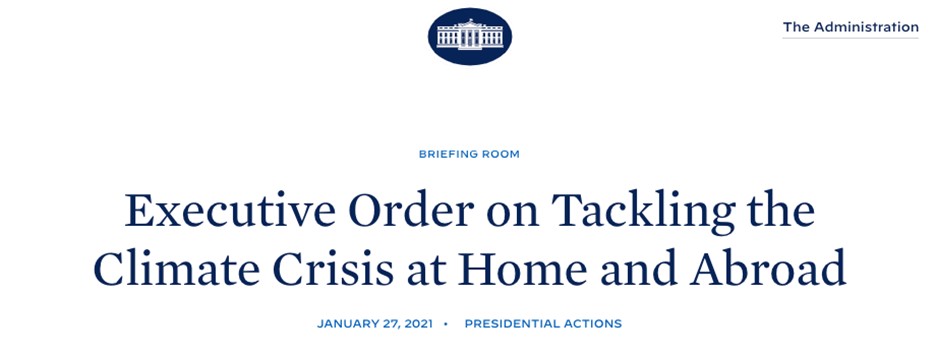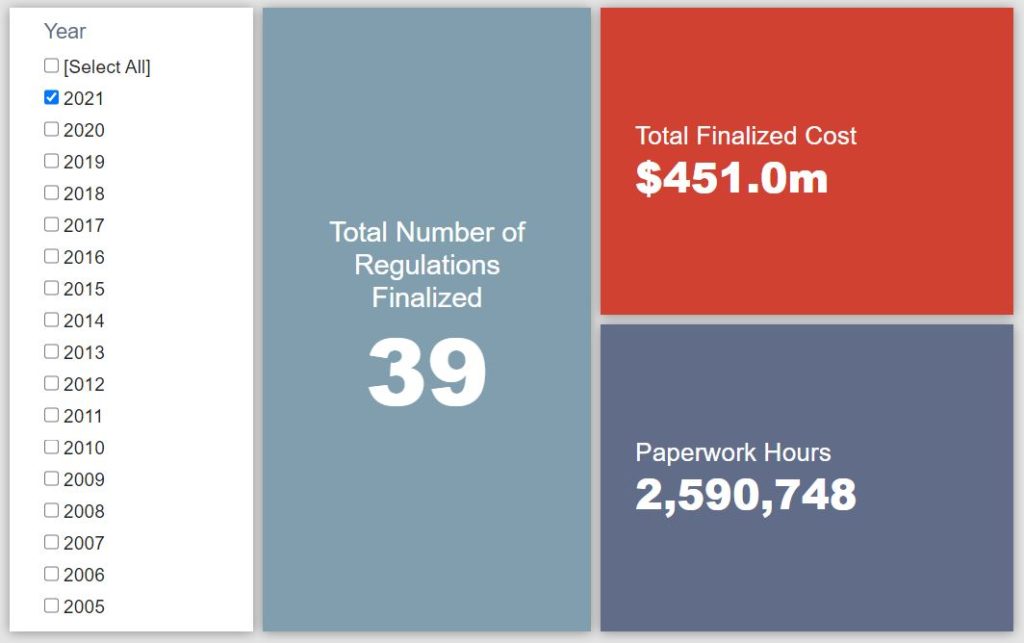Week in Regulation
February 1, 2021
Regulatory Freeze – The Sequel
Approximately four years ago, the newly inaugurated Trump Administration’s regulatory freeze memo took hold. This past week brought the sequel. As the Biden Administration begins its journey into the unknown, only one regulation with a measurable economic impact made it into the pages of the Federal Register. With just that single rulemaking, agencies published $2.3 million in total net costs and added 9,610 hours of annual paperwork.
REGULATORY TOPLINES
- Proposed Rules: 7
- Final Rules: 23
- 2021 Total Pages: 7,606
- 2021 Final Rule Costs: $451 million
- 2021 Proposed Rule Costs: -$8.2 billion
NOTABLE REGULATORY ACTIONS
As mentioned above, there was only rulemaking that had some quantified cost or paperwork burden estimate attached to it. By process of elimination, it is the most notable rulemaking of the week in this regard. The action in question is a proposed rule from the Federal Energy Regulatory Commission (FERC) concerning “Revisions to Regulations on Electric Reliability Organization Performance Assessments.” The revisions FERC makes to these assessments increases that paperwork burden by 9,160 hours and roughly $760,000 in costs annually (or $2.3 million in total across the three-year period a federal paperwork requirement technically covers).
TRACKING THE ADMINISTRATIONS
As we have already seen from executive orders and memos, the Biden Administration will surely provide plenty of contrasts with the Trump Administration on the regulatory front. And while there is the general expectation that this new administration will seek to broadly restore Obama-esque regulatory actions, there will also be areas where it charts its own course. Since the American Action Forum’s RegRodeo data extend back to 2005, it is possible to provide weekly updates on how the top-level trends of President Biden’s regulatory record track with those of his two most recent predecessors. The following table provides the cumulative totals of final rules containing some quantified economic impact from each administration through this point in their respective terms.
![]()
This first week or so of data in a given administration can be an odd one. The newly installed administration will have a regulatory freeze in place, but it is hardly absolute. Rules that do get through that process are generally A) holdovers from the prior administration already in the pipeline that inadvertently get published and/or B) rules from independent agencies that do not technically have to follow the White House directives. The latter category largely provides the bulk of both the high initial cost figure for the Trump Administration (a $2 billion Federal Reserve rule) and the high initial paperwork figure for the Obama Administration (a Securities and Exchange Commission action with roughly 1.6 million paperwork burden hours). It remains quite frigid on the Biden front thus far, but one can expect the regulatory thaw to come sooner than later.
THIS WEEK’S REGULATORY PICTURE
By Thomas O’Rourke, Regulatory Policy Intern
This week, an expansive executive order (EO) on climate change.

On January 27, President Biden signed an EO establishing the framework by which agencies will develop and implement policies directed at mitigating climate change – a clear priority for the incoming administration. The 7,500-word EO contains the White House’s plan to address climate change both domestically and abroad.
The EO, “Executive Order on Tackling the Climate Crisis at Home and Abroad,” establishes the National Climate Task Force (Task Force). The Task Force, which includes the Environmental Protection Agency, Office of Management and Budget, and 19 other departments and agencies, seeks to foster conservation, plan federal environmental policy, and promote environmental justice, among other measures. Moreover, the order calls upon members of the Task Force to prioritize assessment of environmental impacts in the rulemaking process. It can be expected, then, that future cost-benefit analyses of rules will focus on limiting environmental degradation while also promoting use of green technologies and renewable energy.
The order also created two additional councils, each of which seeks to address community-level impacts of climate change. The Interagency Working Group on Coal and Power Plant Communities and Economic Revitalization focuses on developing strategies to restore economic stability to areas with high concentrations of workers in displaced industries. Similarly, the White House Environmental Justice Interagency Council was formed to protect communities disproportionately affected by climate change. The council will also be tasked with creating “clear performance metrics to ensure accountability” among all agencies.
Agencies will also be required to submit a Climate Action Plan to the Task Force, which will assess each agencies’ “climate vulnerabilities.” Action Plans also request agencies to detail specific measures that can be undertaken in order to “bolster adaptation and increase resilience to the impacts of climate change.” In order to ensure that agencies are compliant with their Action Plan, they will be required to submit regular progress reports on their policy implementation.
In addition, the EO calls for departments and agencies to adopt an enhanced role in the Biden Administration’s foreign policy. That is, the EO solicits agencies to assist the president in determining contributions to the recently rejoined Paris Agreement. Agencies will also play a vital role in phasing out financing international fossil fuel-based energy and developing clean-energy alternatives.
Given President Biden’s emphasis on addressing climate change, increased regulatory activity appears to be imminent.
TOTAL BURDENS
Since January 1, the federal government has published $7.7 billion in total net cost savings (with $451 million from finalized rules) and 8.9 million hours of net annual paperwork burden reductions (with 2.6 million hours in increases from final rules).












